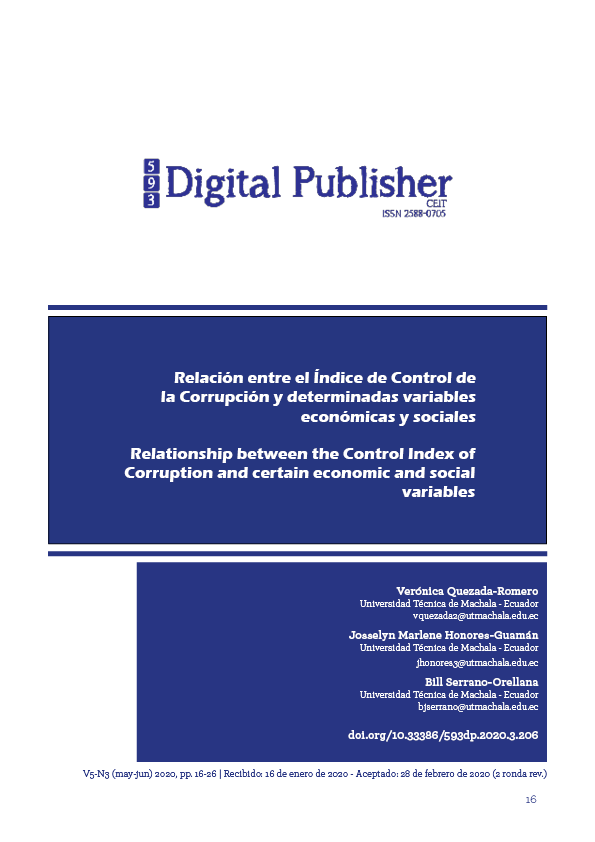Relationship between the Control Index of Corruption and certain economic and social variables
Main Article Content
Abstract
Corruption is a global problem that has generated increasing interest due to its serious consequences on countries, for this reason, the objective of analyzing the economic and social implications of corruption has been raised. To measure corruption, the Corruption Control Index was used, the variables were selected and the correlation analysis was performed. The results obtained coincide with previous research, which shows that corruption affects various economic and social variables.
Downloads
Article Details
1. Derechos de autor
Las obras que se publican en 593 Digital Publisher CEIT están sujetas a los siguientes términos:
1.1. 593 Digital Publisher CEIT, conserva los derechos patrimoniales (copyright) de las obras publicadas, favorece y permite la reutilización de las mismas bajo la licencia Licencia Creative Commons 4.0 de Reconocimiento-NoComercial-CompartirIgual 4.0, por lo cual se pueden copiar, usar, difundir, transmitir y exponer públicamente, siempre que:
1.1.a. Se cite la autoría y fuente original de su publicación (revista, editorial, URL).
1.1.b. No se usen para fines comerciales u onerosos.
1.1.c. Se mencione la existencia y especificaciones de esta licencia de uso.
References
Akçay, S. (2006). Corruption and Human Development. Cato Journal, 26(1), 29-48.
Akhter, S. H. (2004). Is globalization what it’s cracked up to be? Economic freedom, corruption, and human development. Journal of World Business, 39(3), 283-295.
Alcaide Zugaza, L., y Larrú Ramos, J. M. (2007). Corrupción, ayuda al desarrollo, pobreza y desarrollo humano. Boletín económico de ICE, 37-58.
Alm, J., Martinez-Vazquez, J., y McClellan, C. (2016). Corruption and firm tax evasion. Journal of Economic Behavior y Organization, 124, 146-163.
Al-Marhubi, F. A. (2000). Corruption and inflation. Economics Letters, 66(2), 199-202.
Amate Fortes, I., y Guarnido Rueda, A. (2011). Factores determinantes del desarrollo económico y social. Málaga, España: Analistas Económicos de Andalucía.
Appelbaum, E., y Katz, E. (1987). Seeking Rents by Setting Rents: The Political Economy of Rent Seeking. The Economic Journal, 97(387), 685-699.
Báez Gómez, J. E. (2013). Relación entre el índice de control de la corrupción y algunas variables sociales, económicas e institucionales. Nómadas. Revista Crítica de Ciencias Sociales y Jurídicas, 38(2), 137-154.
Blackburn, K., y Powell, J. (2011). Corruption, inflation and growth. Economics Letters, 113(3), 225-227.
Canare, T. (2017). The effect of corruption on foreign direct investment inflows: Evidence from a panel of Asia-Pacific countries. In The Changing Face of Corruption in the Asia Pacific.
Cooray, A., y Dzhumashev, R. (2018). The effect of corruption on labour market outcomes. Economic Modelling, 74, 207-218.
Delavallade, C. (2006). Corruption and distribution of public spending in developing countries. Journal of Economics and Finance, 30(2), 222-239.
Dincer, O., y Teoman, O. (2019). Does corruption kill? Evidence from half a century infant mortality data. Social Science y Medicine, 232, 332-339.
Egger, P., y Winner, H. (2005). Evidence on corruption as an incentive for foreign direct investment. European Journal of Political Economy, 21(4), 932-952.
Gastanaga, V. M., Nugent, J. B., y Pashamova, B. (1998). Host country reforms and FDI inflows: How much difference do they make? World Development, 26(7), 1299-1314.
Gutiérrez Pérez, E. (2018). Corrupción pública: concepto y mediciones. Hacia el Public compliance como herramienta de prevención de riesgos penales. Política Criminal, 13(25), 104-143.
Habib, M., y Zurawicki, L. (2002). Corruption and foreign direct investment. Journal of International Business Studies, 33(2), 291-307.
Hines Jr, J. R. (1995). Forbidden payment: Foreign bribery and American business after 1977. National Bureau of Economic Research.
Jain, A. K. (2001). Corruption: A Review. Journal of Economic Surveys, 15(1), 71-121.
Leff, N. H. (1964). Economic Development Through Bureaucratic Corruption. American Behavioral Scientist, 8(3), 8-14.
Levin, R. I., y Rubin, D. S. (2004). Estadística para administración y economía. Pearson Educación.
Lim, K. Y. (2019). Modelling the dynamics of corruption and unemployment with heterogeneous labour. Economic Modelling, 79, 98-117.
Mauro, P. (1995). Corruption and growth. The quarterly journal of economics, 110(3), 681-712.
Mauro, P. (1998). Corruption and the composition of government expenditure. Journal of Public Economics, 69(2), 263-279.
Moyal, P., Pagano, J. P., Rossi, M., y Rossi, T. (2008). De la percepción de la corrupción a la coima: un puente invisible. Cuadernos de Economía, 27(49), 207-224.
Neu, D., Everett, J., y Rahaman, A. S. (2015). Preventing corruption within government procurement: Constructing the disciplined and ethical subject. Critical Perspectives on Accounting, 28, 49-61.
Ortiz, E. (2012). Efectos de la corrupción sobre la calidad de la salud y educación en Colombia 2004 -2010. Tendencias , 13(1), 9-35.
Rajkumar, A. S., y Swaroop, V. (2008). Public spending and outcomes: Does governance matter? Journal of Development Economics, 86(1), 96-111.
Shleifer, A., y Vishny, R. W. (1993). Corruption. Quarterly Journal of Economics, 108(3), 599 - 617.
Sims, R. L., Gong, B., y Ruppel, C. P. (2012). A contingency theory of corruption: The effect of human development and national culture. The Social Science Journal, 49(1), 90-97.
Timmons, J. F., y Garfias, F. (2015). Revealed Corruption, Taxation, and Fiscal Accountability: Evidence from Brazil. World Development, 70, 13-27.
Treisman, D. (2000). The causes of corruption: a cross-national study. Journal of Public Economics, 76(3), 399-457.
Wei, S.-J. (2000). How taxing is corruption on international investors? Review of economics and statistics, 82(1), 1-11

